Resources:
Seed Savers Exchange
The Seed Garden: $22.46 at SSE
The Seed Garden: $21.29 On Amazon Prime
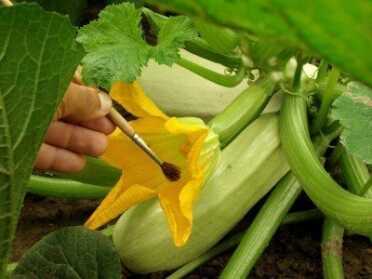
Saving seeds for some types of vegetables is easy, but for some you have to know what you are doing. Squash blossoms like this are hand pollinated and bagged for each individual squash that you want to save seeds from. Otherwise they could be “crossed” with other varieties in the garden.
Some prepping subjects are sexy, and some are decidedly not. But the one thing you always have to remember is that you have to eat and drink, first and foremost. Then it comes down to what you think is going to happen. I spoke to a guy this week who has been a prepping expert for years, including some cool alternative energy stuff. But when pressed, he admitted to me that he isn’t prepared for anything longer than a month or two. That’s great, and it’s way better than sticking your head in the sand and doing nothing, but I think we have a long time of off grid living coming our way, and if you have a bunch of people to feed, that means you would have to grow and regrow some of your own food at the very least. That sounds simple, but gardening is not as easy as you might think. Even if you get things to grow reliably, pests will come along and eat them all up. And then you have to save seeds for next year. That is the spectacularly nonsexy topic of this week’s article.
This overview can’t replace a substantive reference book written by experts on the subject of seed saving, but I will go over some of the basic issues with which you must be concerned. As I said in my first article on seeds and the second one on basic gardening, I have been a member of the Seed Savers Exchange for years as a supporter, not someone who supplies seeds. In the days before the internet took over, SSE used to be a tiny little organization that published a directory of hobby seed savers who passed on specific heirloom varieties of vegetables for a nominal fee. They didn’t really sell anything. But over the years the organization grew, and eventually they purchased some land in Idaho, and used it to grow and sell their own stock supply of heirloom seeds in a registered archive. Now, in 2015 as I write this, they have an annual budget of over 5 million dollars, and all of that money still goes into grass roots, mostly volunteer driven, seed saving activities in the US and around the world. In recent years SSE has expanded to fruit tree grafts, as well as seed potatoes and even propagated berries. I’ll get to what some of that stuff means below.

I have used this book, Seed to Seed for over a decade as my reference manual, but it has been replaced by a new book from Seed Savers Exchange.
The goto book for seed saving for over a decade has been Seed to Seed, by Suzanne Ashworth, and the SSE has promoted and sold that book since 2002 when it was written. This spring Seed Savers published an update to that book called The Seed Garden. If you bought Seed to Seed last year after that last article, I don’t think there is a monumental difference between the two, but The Seed Garden does have some new botanical details about some varieties, and it has some cool “Master Class” sections that taught me a lot of stuff I didn’t know, and they seem to all be based on experiences of active seed savers.
I am going to back up two paces briefly, because I tend to skip a lot of introductory ideas in my articles and just jump to the stuff I’m pretty sure you don’t already know. If you haven’t experimented with gardening, you may not have ever even looked at a vegetable seed. Some veggies have obvious seeds, like tomatoes, but what does a lettuce seed look like? You can get celery seed as a spice, but how do you get those seeds when regular celery is just a stalk and some leaves? Can you just save seeds from supermarket vegetables? How long do they last? How can you make them last longer? I’ll get to some of that, but don’t feel like those are silly questions. Most people have absolutely no clue how plants actually grow.
Pollination, Propagation, Vernalization and other Tongue Twister 50 cent Words
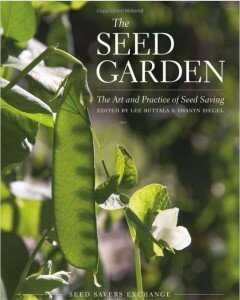
This new book, The Seed Garden, is not that much more substantive information, but it is presented in a slightly better writing style for many sections, and a lot of the more complex ideas are broken out into “Master Class” sections in which I found a lot of new information.
Botanical books all have the same big problem, and The Seed Garden is no different. For one, the writing is terrible. Granted, the books are or new gardeners and experienced botanists, but I think they could do a lot better at using active voice rather than almost 100% passive voice, and most books don’t even explain the technical words within the text. If there is a glossary you are lucky, and otherwise they just assume that you know what the heck they are talking abot. I can say that The Seed Garden does at least a passable job of isolating the botanical terms, and there is a pretty good index and common name guide when it comes to the second half of the book, which is how to save seeds for individual types of vegetables, set up by botanical classification.
These are not complex subjects! Don’t be scared away. Language and writing style make them seem complex, but buried in all of the botanical words are simple things you need to do if you want to save seeds, and none of them are that difficult. For example, you have maybe never seen a lettuce seed, but saving seeds for lettuce is involves a very complicated procedure of simple not picking the lettuce. Yea, that’s it. If you don’t cut your lettuce it eventually will “bolt” and send up a seed pod. Wait for that to mostly dry out and you’ll have hundreds or even thousands of lettuce seeds, and since lettuce has both male and female parts in each plant, and those parts mate before the pod even comes up, no worries. You’ll have viable lettuce seeds true to type on your first try.
In the book, first you learn about how plants pollinate themselves so that the seeds are fertile. As with the lettuce, some vegetables have both a male and female part on each flower, and they pollinate themselves without any real interaction with the outside world. Beans and many other plants have no special circumstances that you have to deal with to get your seeds to grow true to type. Some plants, like tomatoes, can pollinate themselves, but if there are bees or flies around, there is a pretty good chance that the plants in your garden, or even your neighborhood, will “cross” with each other, and that the seeds from the veggies that grow will not grow true to type. Some plants, like squash, don’t have both male and female parts in one flower, so pollinating insects have to do the heavy lifting of pollination for them. And some plants, like beets, spinach, and corn, use the wind to pollinate, so even a small gust can “cross” them with others of the same type but different variety within even miles of each other.

Some vegetables can pollinate themselves, but they also can be cross pollinated by insects. These are pepper isolation cages. You alternate opening the sides every day so that the varieties aren’t crossed by insects jumping from plant to plant.
Isolating plants, or more likely a group of plants of the same type, is how you deal with the potential to cross. If there is most important topic when it comes to seed saving, isolation is probably it. Most people building a home garden expect their veggies to grow true to type, and that can sometimes be really difficult. Corn has to be isolated by miles if you expect to save seeds. Peppers and tomatoes usually need actual isolation cages if you expect to grow more than one variety on your property, especially if you expect to sell your seeds as pure. Most seed savers actually pinch off and hand pollinate squash from flower to flower, then they put a screen bag the hand pollinated bud. The Seed Garden explains all of this in the first part of the book, then lists in encyclopedic fashion the challenges that seed savers have experienced with growing that type of plant for seed.
From a survival perspective, food is food is food right? We aren’t talking about a hobby garden, where if you grow a patch of a carrots called “St. Valery,” then save the seeds from that carrot patch, you expect to get carrots that look like St. Valery. In a survival situation, if that carrot accidentally crossed with a variety that you had planted on the other side of the garden and the carrots don’t look just like St. Valery, big deal. You can still eat them. (as an aside though, carrots specifically will cross with the weed called Queen Anne’s Lace, which is not good).
Is it better to keep your varieties pure in a survival world? Yea, I think so, probably. Knowing what is coming out of the ground is better than not. And as society repairs itself, you could sell your seeds as true heirlooms.

Some plants aren’t generally grown from seeds like rhubarb, which is a perennial even in the coldest climes. Most people use vegetative propagation for asparagus and of course potatoes and sweet potatoes.
Some veggies, like asparagus, rhubarb, and both regular potatoes and sweet potatoes are usually propagated from either pieces of plant or roots. Any perennial can be grown this way, but in general seed savers prefer seeds if viable seeds are available from the plant. I discovered in Florida that tomatoes and eggplants are actually perennials as well, but rarely are these plants kept year to year.
Vernalization is the ultimate botanical 50 cent word in my opinion. Some veggies require two years in the ground to produce seeds. They are called biennials, and they include some pretty common things like carrots, beets and cabbage. Vernalization is a period of cold that these root veggies need to set the seed next season, and in cold climes, you have to dig them out of the ground and keep them in some sort of root cellar arrangement. Carrots, for example, need temperatures below 50 degrees F for 10 weeks or less to set seed next year. The Seed Garden has a “Master Class” on the subject, and as I said above, I think these focus sections make the book head and shoulders above the old book Seed to Seed. There are incredibly well written sections on hand pollinating squash, all of the different flies and bees that pollinate flowers, and on cleaning seeds from both wet and dry vegetables. I started keeping honey bees this year as pollinators, and I found out in the book that they are not the strongest pollinators on a number of important vegetables.
To Grow Or Not to Grow – That is the Question!
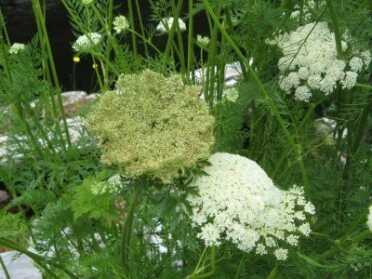
I suggest that you begin gardening, even if you fail. Believe it or not, these are carrot flowers! Carrots have to be “vernalized” over winter and the flowers come up in the second year. Notice how much they look like Queen Anne’s Lace, which carrots will cross with.
As my regular readers know, I am a strong proponent on going as “all in” as you can depending on your life circumstances. This spring I tried planting about 75 containers of veggies in my backyard, just to see what would go wrong. Everything went wrong lol. I never got around to putting in my drip irrigation so our South Florida drought put my plants on the verge of death more than a few times when I had to go away for a few days and couldn’t water them daily. The weakest of the plants were consumed by giant green caterpillars, and those little bastards ate my trumpet plant too! All of these months later it looks like I’ll get some watermelons and winter squash out of the effort, and I have picked some stunted occasional peppers, but of all my tomato varieties, only the tiny cherry tomatoes have produced more than one fruit, and a grey squirrel has destroyed most of the larger tomatoes that have even come out. I had a two acre organic vegetable farm for many years in Western Massachusetts once, so I know kinda what I’m doing. Growing veggies in South Florida is really tough, but I’m going for it in the ground this fall.
Needless to say, but I’ll say it. Whatever you can do to start learning these concepts in the real world are a good idea, even if you can’t do them perfectly. Survival isn’t going to be perfect either.
Replacing Your Seeds
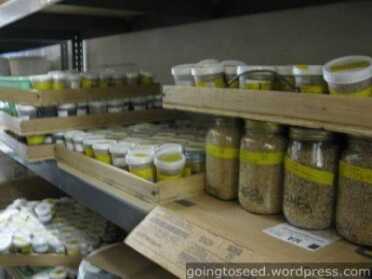
Whether you are saving seeds or buying seeds to save, if you dry them out and store them in Mason jars or mylar bags it will keep them dry, which makes them last longer.
If you are like me, I’m not doing any substantive seed saving right now. I buy my seeds from those Ebay sellers and others I suggested in my first article, and I put in a large order to Seed Savers Exchange every year. This year I’m going to order some of the members’ seeds, just to support the cause, but SSE has de-incentivized this because the seeds from members are no cheaper, and it is so painfully easy to order the SSE maintained seeds on their websites. If I had a complaint of SSE it would be that they have not done a great service to their members by offering their seeds at roughly the same price. Unfortunately the small time seed business is not a big money maker, so they do what they have to do to survive as a viable seed bank.
Moisture is the enemy of saved seeds. This year I’m going to dry my seeds with desiccant packages as it explains in The Seed Garden, then put them in airtight containers or mylar bags. Freezing properly dried seeds at chest freezer temps will preserve them almost indefinitely. But beware that your home fridge/freezer is not a good substitute. Home combo units have an automatic defrost cycle that brings down the temp of the freezer below where the seeds need to be. A small chest freezer with a backup power source, like a battery bank and inverter, is going to be much more reliable, and I’m going to build one of these and do an update article with the components at some point soon. After the spring you can get good deals on bulk seeds, but they have to be dried and stored properly if they are to be of any use. I was shocked this spring when more than 50% of my seeds purchased the prior spring didn’t germinate, and those seeds never left an air conditioned, which is dehumidified, environment.
Free Seeds from the Supermarket?
The one question I haven’t answered here is whether you can save supermarket veggie seeds for growing. The general answer to that question is yes, and I have experimented with both tomatoes and squash, both of which for the most part have mature seeds when harvested for eating. I don’t suggest you try this with the veggies you like the day after the collapse. Try it now. And some seeds are definitely not mature enough for saving, like string beans. But on the flip side of this, dried beans bought for eating are usually fertile, and they grow true to type because beans have a self fertilizing, perfect flower. The same is true of raw peanuts from what I have read, and I am going to try that this year.
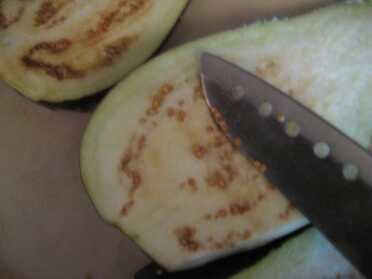
I have successfully saved and grown tomato and winter squash seeds from the supermarket, but from what I read it would be a dead end with eggplant, which requires that you leave the fruits on the vine after they would be picked for eating. The same is true for green string beans, but dry beans in bags at the supermarket can generally be grown, as can whole feed corn.
I have read now that eggplant seeds require that the fruits are left on the plant beyond when you would pick them for eating, so I don’t think supermarket eggplant are viable. And don’t forget, if you go back to my first article, that a lot of supermarket vegetables, as well as a lot of the seeds on the Walmart seed rack, are what are called F1 Hybrids. They are a cross of two very different types, and the seeds will not be true to type in the 2nd generation.
And I really should mention GMO crops. All of the sugar beets in the US are now GMO, so if you are growing beets for seed in beet country, you will have to use use fine cages. Likewise corn in commercial corn country. There is very little corn in those fields now that isn’t GMO. For that matter, there is very little corn at all that hasn’t been contaminated with GMO. Some of the original cornfields in Mexico, where corn originated, have tested positive for GMOs. Whether you think GMO veggies are a health risk or not isn’t even the whole issue. Officially you will be violating a patent if you save seeds from any GMO crop, whether it was pollinated by GMO intentionally or by mistake.
More than anything, get the book so you have the resource, should you find yourself in a situation where you need to know this information. Right now a lot of it could be found in pieces on the internet, but when the internet goes dark, and it will go dark, you are going to be on your own with your books in your seeds. I would start a garden now if you can, even in containers, but even if you can’t, The Seed Garden makes a respectable coffee table book, and you might be inspired to start your own seed vault!

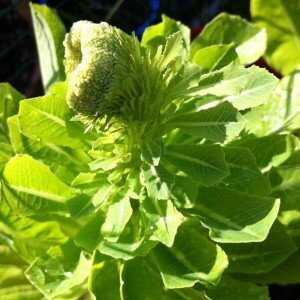
Um… hello? Did this person actually PLANT any of these crops? Most, if not all store vegetables are hybrids. The seeds are infertile. You will usually get flowers and no fruit or stunted fruit that looks nothing like the vegetable you bought. Monsanto has been there and sells most of the crop seeds. The second generation is usually infertile.
I have zero patience with mistakes in copy, grammar mistakes. Please, please have someone knowledgeable, preferably over the age of 45, read and correct your copy. Lousy sentences that convey nothing except that the author seems to find himself adorable. “Stuff” and “cool” and “lol”? Please. I realize that these words are in common use, but they DO NOT make for good writing. Please spare us, and if you are grabbing a platform, you better be up for the responsibility.
Great article. Very informative and interesting, even if it was highly condensed. Having gardened in S. Florida for the last 7 years I understand a lot of the trials you faced but I will also warn you now you have more to go. Just wait until you encounter root knot nematodes.
Yea been there done that. Plants grow, flower, but no fruits at all. It’s bullshit.
GMO No!!!! What other corporation spends billion against the labelling of their product???? Not one, because the majority of Americams realize how harmful GMOs are. Seeds of Death by Gary Null explains how GMOs change us genetically, impacting DNA and telomers, and render infertility by the second generation.
First comment = specious.GMOs are death seeds with no proven benefit except to help TPTB in slow kill methods. Wake up. Who fights labels…most companies spend bilions to label instead of NOT LABEL!
Good article–it’s never too early to start honing your gardening skills. As you implied, there’s definitely a learning curve, and every garden spot has its quirks. Mine is too dry, my brother’s is too wet. What strikes me is just how much you have to produce to actually have a surplus. My grandmother produced most of their own vegetables which she canned and stored. Her garden was at least an acre of intensely cultivated land. Her summers consisted of gardening and canning and not much else.
what is gmo
Elmo’s far less tickle friendly cousin…….or Genetically Modified Organism
Just purchase Non GMO seeds, They are available online from any number of places.
Some even come packed for long term storage and the seeds are true from plant year to plant year.
Overall good article with useful information. Well done. One thing sticks in my craw, however:
“Officially you will be violating a patent if you save seeds from any GMO crop, whether it was pollinated by GMO intentionally or by mistake.”
Oh no!!! And in a survival scenario you would care because??? And please don’t give us “it’s a legal or moral obligation” for you to warn people. It’s just plain nonsensical. It’s akin to telling someone that they might not want to swipe that loaf of bread to feed their starving child because, well, it would be stealing. The last thing on my (or any sane person’s) mind in a SHTF scenario would be the intellectual property or patent rights of millionaires, billionaires and multinational corporations.
Besides, can you imagine folks with special collection equipment driving from homestead to homestead taking samples of crops to send off to a non-existent/non-functioning lab across the country to see if they are violating any patents? In a SHTF scenario? Even years after the collapse of society? Seriously? It would be at least a decade after a collapse before we’d ever get back to the point that this might conceivably happen.
And one last thing. GMO foods are perfectly safe for consumption. One can “think” they are a health risk all they want but the evidence simply isn’t there. Numerous third party studies bear this out.
If GMO foods are safe to consume why do the elites consume organic foods.
BAM!!!
If GMO’S are so safe why does the White House eat Organically?
Actually, you should research way back when we were first learning about GMO Feed Corn that was used to feed our mega-farm beef suppliers. Reduced fertility rates, Low-birth weights, Immune system failings, lowered resistance to diseases, etcetera, etcetera… There were all kinds of problems connected to the consumption of GMO products… and that was at the tier 1 stage of the food chain… Who knows how bad it gets as you step up the food chain ladder… They quit publishing those research results, or they simply quit researching. I for One, do not wish to consume them at all, ever! And I think that should be My choice. I do not think that the Federal Government has the authority to interfere! Furturmore, I think the FDA should be 100% government funded, and shall not have the ability to be contacted by anyone, ever, regardless of who is trying!